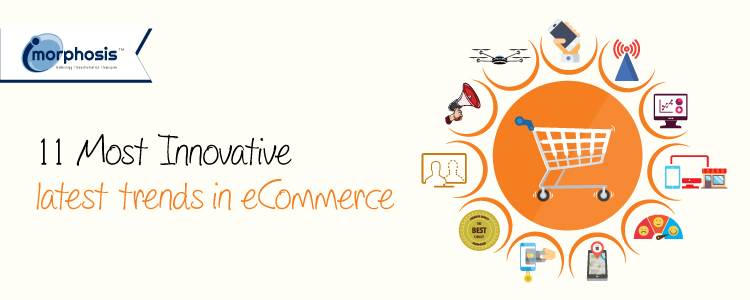2016 is another great year for the eCommerce industry. The year-on-year data shows that there is a continuous growth in the online sales this year. By analyzing the growth curve the experts expect that there will be a consistent growth in the following years. For both the established brands and e-Commerce startups, it is important to follow the latest trends in eCommerce that have fetched high returns and implement strategies to get a competitive edge.
As per a statistics portal, the revenue of eCommerce in 2016 (till date) is almost mUSD 1,182,575.0 worldwide. The revenue is expected to grow at a CAGR (Compound Annual Growth Rate) of almost 10.72 percent, leading to a market volume of mUSD 1,777,095.7 within the year 2020. In 2016, the user penetration is about 65.1 percent and it will shoot up to 70.18 percent by 2020. These numeric explain well the growth statistics in the eCommerce industry.
To achieve the business goal, it is not enough for the ecommerce stores have unique and nice items in their inventory. Customers are now increasing savvy, they are demanding. So, shopping experience matters most to them than what they buy. They expect a certain level of customer service like the ease of shopping, timely delivery, payment process and loyalty offers. The focus will be more on customer experience.
If e-tailers want to keep up with their competitors, then need to follow the latest trends in eCommerce. These trends are in sync with the technical advancements like omnichannel integration, contextual shopping, big data analytics, use of beacons and sensors and use of multiple devices.
Latest trends in eCommerce to look for
In the competitive landscape, what matters is how the customers experience the brand. Brands that can predict the customer expectations based on their past purchasing behavior, meet those and actively engage with customers- online or mobile, are the winners. Sticking to the brand-centric approach will reduce the chance of brands to earn revenue and increase the customer base. To stay competitive, brands need to abide by the latest trends in eCommerce to ride the growth curve and reach the zenith by the end of this decade.
- Smartphone rules the market – Criteo suggested that the share of mobile in the global eCommerce market will increase from 40 percent in 2015 to 70 percent in 2017. As per a study by Demandware, in the first quarter of 2016, smartphone accounted for almost 45.1 percent web traffic who shopped in the eCommerce stores. The study suggests that the smartphone will be a major contributor of traffic (almost 60 percent) by the end of 2017. Smartphone provides retailers to reach the customers easily.
- Beacons and RFID tags will drive more sales – Beacons are connected wireless devices that help retailers to send and collect information. These Bluetooth-connected devices help in tracking the movement of targeted customers inside the stores and provide relevant information to the prospective buyers likewise. Beacons integrate the offline and online worlds- for instance, if a customer hangs out in any particular section of a physical store, beacons recognize it and send information through the eCommerce sites. The report suggests that beacons will increase the sales from USD 4 billion to USD 44 billion in the year 2016. By the end of 2018, retailers will install approximately 3.5 million beacons. Within the next five years, retailers will invest USD 2.5 billion in RFID tags and beacons (both IoT-enabled devices). Regardless of the location, beacons ensure a seamless shopping experience.
- Big data analysis increases business margin – Traditional analytics will take a back seat and will be replaced by big data analytics. E-tailers now emphasize on real-time analytics as it helps in the decision making process. Retailers who have already integrated big data has experienced an average increase of 60 percent in the business margin and a considerable improvement in the labor productivity. Companies implementing predictive analytics have experienced 73 percent higher sales. Real-time analytics highlights the customer habit, behavior, problems faced by them and provide services based on it. You can customize the offers based on the real-time analytics. In short, it will be instrumental in increases shopping experience and sales.
- Omnichannel rules – According to Google, almost 85 percent of customers start shopping with one medium or channel and conclude it on another one. Multichannel shopping will be high in the next few years. It is a perfect blend of the best attributes of both online and offline channels. With the fast changing eCommerce landscape, now retailers aim at providing omnichannel experience to customers.
- Contextual shopping and an enhanced shopping experience – To get competitive advantage, it is important for the eCommerce stores to emphasize on user-centric and optimized customer experience. The majority of the executives (almost 89 percent) believes that customer experience is will be the game changer. It will be the most important factor that will give a competitive edge to the eCommerce stores. Correct context- relevant information to guide customers in purchase decision making, will become the new form of personalization. Context shopping will take the experience of customers much beyond item recommendation and personalized greetings. This customer-centric technology can map the customer journey, anticipate needs and provide information to ensure a hassle-free shopping experience.
- Location-targeted ads – Location-targeted ad revenues will grow from USD 4.3 billion in 2014 to USD 18.2 billion in 2019. By using the location of customers, you can send them across personalized messages and advertisements. These ads are based on real-time data which provide brands the opportunity to create personalized moments for target audiences. Thus, businesses can tailor-make their offers and advertisements as per specific markets, local trends and language.
- Flexibility in payment – Payments will be more focused on mobile. But apart from the traditional method of using credit and debit cards, customer can now use flexible payment options. E-tailers first need to know the preference of their customers and integrate the same in the payment procedure. Using payment gateways preferred by the customers will also prove to be cost-effective.
- Loyalty programs – Studies show that to acquire new customers, businesses need to spend 5 to 10 times more than selling products to the existing customer base. Statistics prove that existing customers spend almost 67 percent more than new customers. Reward and loyalty programs act like a magic wand. Loyalty programs are generally aimed for customers who make maximum purchase. Be it the point system or tier-wise rewards or free benefits, loyalty programs help in improving the conversion rate. Main aim of loyalty points is to improve customer retention and happiness.
- Magic Mirrors – It is one of the most innovative latest trends in ecommerce. Brands now use the magic mirror technology and RFID tags that help customers to try out the virtual outfits. Touchscreen mirrors help the buyers to select various lighting options, request sizes, colors, and they can keep a track what they have tried earlier. Investing in mirror technology makes sense as this is an important factor responsible for the conversion. It is an innovative way of interacting with the customers.
- Flash sales – Buyers are impulsive, if they get a good deal, they often tend to purchase a good even if it is not planned. Impulse is the key to success for Black Friday, Cyber Monday or Singles Day. Flash sales on these days comes as a surprise and products are available at an unexpected low price. In 2015, Cyber Monday in the USA witnessed the maximum online shopping, in China Singles Day had seen the highest online sales. It is expected that these days will see greater influx of customer in the coming years. Even if the targeted customers do not purchase anything on these days, there is a chance that they will remember the brand and come back to the website later.
- Faster and instant delivery – Same day delivery will soon be the rule of the game. Customers become impatient when they have to wait for 3 to 4 days or more for products they purchase online. ECommerce giants like Amazon who have Prime option that ensures fast delivery among other offers. Same day and fast delivery guarantee that your target audiences will return back to the eCommerce store. It gives a competitive edge to the stores and boost the customer count in terms of cross-border sales.
Source EITG
Following these latest trends in ecommerce will prove to be beneficial for the e-tailers. Latest technology to be integrated by the eCommerce stores also emphasizes on improving customer experience. In comparison to the past few years the maximum focus of the eCommerce stores should be on customer experience and seamless shopping.




